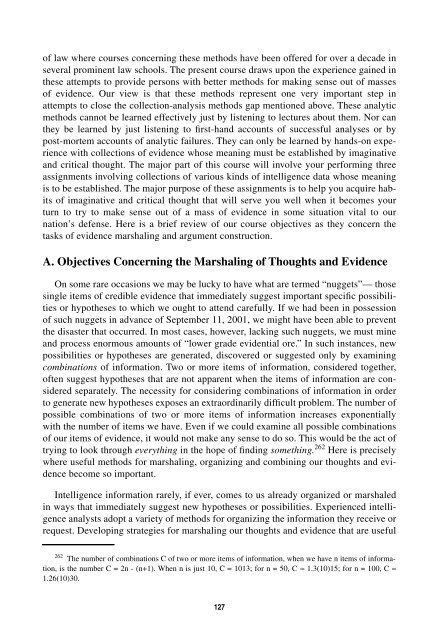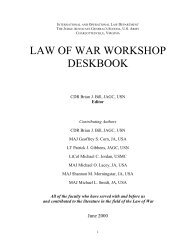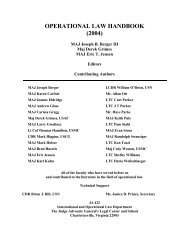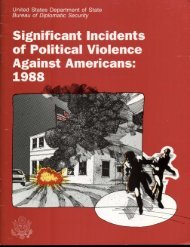learning with professionals - Higgins Counterterrorism Research ...
learning with professionals - Higgins Counterterrorism Research ...
learning with professionals - Higgins Counterterrorism Research ...
You also want an ePaper? Increase the reach of your titles
YUMPU automatically turns print PDFs into web optimized ePapers that Google loves.
of law where courses concerning these methods have been offered for over a decade in<br />
several prominent law schools. The present course draws upon the experience gained in<br />
these attempts to provide persons <strong>with</strong> better methods for making sense out of masses<br />
of evidence. Our view is that these methods represent one very important step in<br />
attempts to close the collection-analysis methods gap mentioned above. These analytic<br />
methods cannot be learned effectively just by listening to lectures about them. Nor can<br />
they be learned by just listening to first-hand accounts of successful analyses or by<br />
post-mortem accounts of analytic failures. They can only be learned by hands-on experience<br />
<strong>with</strong> collections of evidence whose meaning must be established by imaginative<br />
and critical thought. The major part of this course will involve your performing three<br />
assignments involving collections of various kinds of intelligence data whose meaning<br />
is to be established. The major purpose of these assignments is to help you acquire habits<br />
of imaginative and critical thought that will serve you well when it becomes your<br />
turn to try to make sense out of a mass of evidence in some situation vital to our<br />
nation’s defense. Here is a brief review of our course objectives as they concern the<br />
tasks of evidence marshaling and argument construction.<br />
A. Objectives Concerning the Marshaling of Thoughts and Evidence<br />
On some rare occasions we may be lucky to have what are termed “nuggets”— those<br />
single items of credible evidence that immediately suggest important specific possibilities<br />
or hypotheses to which we ought to attend carefully. If we had been in possession<br />
of such nuggets in advance of September 11, 2001, we might have been able to prevent<br />
the disaster that occurred. In most cases, however, lacking such nuggets, we must mine<br />
and process enormous amounts of “lower grade evidential ore.” In such instances, new<br />
possibilities or hypotheses are generated, discovered or suggested only by examining<br />
combinations of information. Two or more items of information, considered together,<br />
often suggest hypotheses that are not apparent when the items of information are considered<br />
separately. The necessity for considering combinations of information in order<br />
to generate new hypotheses exposes an extraordinarily difficult problem. The number of<br />
possible combinations of two or more items of information increases exponentially<br />
<strong>with</strong> the number of items we have. Even if we could examine all possible combinations<br />
of our items of evidence, it would not make any sense to do so. This would be the act of<br />
trying to look through everything in the hope of finding something. 262 Here is precisely<br />
where useful methods for marshaling, organizing and combining our thoughts and evidence<br />
become so important.<br />
Intelligence information rarely, if ever, comes to us already organized or marshaled<br />
in ways that immediately suggest new hypotheses or possibilities. Experienced intelligence<br />
analysts adopt a variety of methods for organizing the information they receive or<br />
request. Developing strategies for marshaling our thoughts and evidence that are useful<br />
262 The number of combinations C of two or more items of information, when we have n items of information,<br />
is the number C = 2n - (n+1). When n is just 10, C = 1013; for n = 50, C ≈ 1.3(10)15; for n = 100, C ≈<br />
1.26(10)30.<br />
127

















